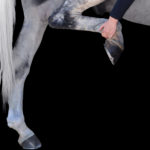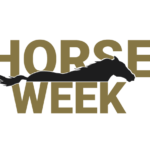June 10, 2012 — America’s Olympic dressage team is shaping up. There’s another weekend of selection trials to go at the U.S. Equestrian Team Foundation headquarters, but the Grand Prix and Grand Prix Special this weekend showed some real potential for the U.S., as our riders prepare for the most competitive international dressage confrontation? in history.
Predictably, Steffen Peters leads the way on his number two horse, Legolas. Ravel, his World Cup and World Dressage Masters champion (who also won two bronze medals at the 2010 World Equestrian Games), stayed home in California after getting a bye from the trials.
 Steffen Peters leads the selection trials for the Olympic dressage team on Legolas. | Photo ? 2012 by Nancy Jaffer
Steffen Peters leads the selection trials for the Olympic dressage team on Legolas. | Photo ? 2012 by Nancy JafferLegolas? didn’t let anyone down. Steffen took him to a score of 77.933 percent today in the Special at the Dressage Festival of Champions, though there was dramatic shrinkage in the edge of nearly four points he enjoyed in yesterday’s Grand Prix over his WEG teammate, Tina Konyot and Calecto V. Tina put in a remarkable test with the black Danish stallion to earn 76.667 percent, a good measure ahead of another WEG team member, Todd Flettrich on Otto (73.067). That horse, also Danish-bred, looks more substantial and much improved since the last time I saw him a few months ago.
These scores all are more than respectable; they’re impressive. But the U.S. will need every percentage point it can get in London this summer. Not only are the Germans, European Champion British and Dutch readying their medal assault for gold and silver, but the Danes and Swedes also are contenders (for bronze) and now the Spanish are emerging as possibilities, too. Their strongest rider, Beatriz Ferrer-Salat, who won individual bronze at the 2002 WEG, today topped the Grand Prix Special on Delgado (75.76 percent) at the Fritzens-Schindlhof show in Austria, beating Great Britain’s strong man, Carl Hester on Uthopia (74.36). Meanwhile, Spain’s feisty Fuego (remember that dynamic gray from the 2010 WEG?) was third with 73.98 percent under the guidance of Juan Manuel Munoz Diaz.
But let’s put things in perspective. The very experienced Ravel should be able to score higher than Legolas, a 10-year-old Westphalian gelding who is undefeated at Grand Prix. If the other U.S. team members do their part and can hit the mid-70s, prospects are looking up.
I asked the team’s technical advisor, Anne Gribbons, what she thought about the way the horses looked this weekend.
To me, Legolas is a not-so-secret weapon. Only three people? are allowed on a team, and there is no drop score. So it’s vital that Steffen, the only U.S. rider in the world top 20 rankings (15th with Ravel, 17th with Legolas) can participate.? And having Legolas as such an able back-up makes for a nice comfort zone. Although Legolas has had some fumbles with the 1-tempis in the past (yes, as recently as yesterday) today he had them down pat, a nice milestone in his progress.
 The top six at the halfway mark of the trials; Guenter Seidel, sixth; Adrienne Lyle, fifth; Jan Ebeling, fourth; Todd Flettrich, third; Tina Konyot, second and Steffen Peters, first. | Photo ? 2012 by Nancy Jaffer
The top six at the halfway mark of the trials; Guenter Seidel, sixth; Adrienne Lyle, fifth; Jan Ebeling, fourth; Todd Flettrich, third; Tina Konyot, second and Steffen Peters, first. | Photo ? 2012 by Nancy JafferI asked Steffen how he would feel if something went wrong with Ravel (please don’t let that happen!) and he had to ride Legolas in the Games.
Anne told me six horse/rider combinations will ship to England next month to prepare for the Games, and Legolas likely will go as a seventh horse. At this point, in addition to Steffen, Tina and Todd, others in line to cross the pond would be Jan Ebeling and Rafalca, who looks better than I had ever seen her go; Adrienne Lyle and Wizard, who save for a break into the canter in the trot half-pass might have overtaken Jan, and Guenter Seidel with Fandango.
 Guenter Seidel and Fandango. | Photo ? 2012 by Nancy Jaffer
Guenter Seidel and Fandango. | Photo ? 2012 by Nancy JafferIt is so great to see Guenter back in action. Last year, the Olympic and WEG multi-team medalist came to the championships horseless. He suffered a broken pelvis in a fall in 2010 and was sidelined for quite a long time. Then his sponsors of 20 years, the Browns (in honor of whom the arena at the USET Foundation is named) decided to call it quits. In January, though, he got back in the game with Marie Meyers’ mount, Fandango, and their partnership continues to improve. The only other time he rode him in competition was at the World Cup Finals in 2009, when he did a pas de deux to the music from “Phantom of the Opera.”
Guenter is such a nice guy, and such a great rider. It’s gratifying to see him in the ring again. We talked about how it’s going.
As Anne said earlier, the historic USET Foundation grounds never looked nicer. But some things were missing from this weekend’s competition. There were no victory passes in the Grand Prix ranks, just unmounted victory strolls, as riders came into the ring with their ribbons, smiled for a photo, and left. The reason? Concern that one of the horses might be injured if riders rode for their ribbons. That seems rather over-protective. I miss the energy of results well-rewarded with a be-ribboned ride around the ring, and that’s important for spectators, too.
 Jan Ebeling and Ann Romney, one of the owners of Rafalca. | Photo ? by Nancy Jaffer
Jan Ebeling and Ann Romney, one of the owners of Rafalca. | Photo ? by Nancy JafferThe other thing that is missing is the Grand Prix freestyle. Riders (some of whom now say they wish they could ride the freestyle) were consulted when plans for the trials got drawn up, and they decided two Grand Prix and two Grand Prix Special classes would be enough for the horses. I got that from George Williams, president of the U.S. Dressage Federation and chairman of the U.S. Equestrian Federation’s High Performance Dressage Committee.
He explained that because the Olympic Special is a new test this year, riders felt they needed more practice doing it under the eye of the judges. Since five classes would have been too much, it was felt an extra Special in place of the freestyle would work best. That’s especially important because unlike previous Olympics, the team medals will be awarded based on the combination of the Grand Prix and the Special, not just the Grand Prix.
Also, the freestyle in the Olympics is only used to determine the individual placings, and it’s felt that the team medal is always more important. So there you have the reasoning; it’s a disappointment for spectators, though, who will have to be content with the Intermediare I freestyle next Sunday.
In the good news column, it looks as if the U.S. will get an extra rider who can compete as an individual. Nothing is confirmed yet, but it seems unlikely two Colombians are going to be able to qualify for the Games by earning 64 percent in competition. One of their spaces would be filled by an Irish rider, who is first in line, while the U.S. is next on the waiting list. Although the team still would not have a drop score, just fielding the extra rider feels like a cushion of sorts.
There’s lots more going on over the nine-days of competition here than just the selection trials. Tomorrow through Wednesday, it’s the Paralympic trials on a different section of the property. I had been anticipating seeing Courtney King-Dye competing. As you’ll remember, the 2008 Olympian was left in a coma after striking her head in a terrible 2010 fall when she wasn’t wearing a helmet. She has struggled back valiantly, but her recovery is far from complete. Riding has helped her keep going and given her a goal. While Courtney qualified to ride in the trials, the horse she was using didn’t like the fact that Courtney wasn’t steady in the saddle because of her condition. She had to give up her place in the trials, but she didn’t give up her dream. That’s what keeps her going.
“Of course, my goals are always really high, but it’s something to work for,” she told me after watching the Grand Prix. I can only imagine how she felt; she was in the Olympic trials as an able-bodied rider just four year ago.
Although she’s now focusing on the 2014 WEG, she noted, “It’s not making it that I’m concerned with; I really like having a goal.”
By the way, yesterday was International Helmet Awareness Day. How disappointing to see that only six of the 15 starters in the Grand Prix wore protective headgear. The others were still in old-fashioned top hats that will do nothing for the wearer in case of a fall. Courtney feels her personal tragedy had a plus side in that it heightened people’s recognition of the importance of helmets. She has heard from many riders who have been saved because her accident brought home the point that everyone who is mounted should wear a helmet.
The next generation of riders also was featured at the show, which is the national championships. Brandi Roenick, an Arizonan who trains with Steffen (and actually lives with him and his wife, Shannon, in California for much of the year) earned the Young Rider Championship with victories in tests yesterday and today aboard Pretty Lady, the mare she trained with the help of her mother.
Brandi wants to be a professional horsewoman, but she’s a smart cookie, emphasizing she will go to college “just in case” something happens with her career plans. Oh, she also wants to go to cosmetology school; she’s interested in doing make-up, but just as a hobby.
The Junior Championship went to Ayden Uhlir of Texas on Sjapoer.? She’s a real entrepreneur; I saw a sign posted near the indoor ring, advertising that Ayden would strip stalls for $60, and asked her about it. Turns out, she saw a pair of breeches she wanted, but felt she shouldn’t ask her mother to fork over the money.? Hence the sign, that brought her plenty of customers–she’ll be able to buy several pairs of breeches by the time she’s through.
The Pony Championship and Reserve both were won by Barbara Davis of New Jersey, on Poldy 10 and Bohdjan. The latter got an extra test of his composure when a storm warning buzzer went off while he was performing, but he handled the distraction. The division was much improved over last year, when there were only two competitors, one of whom was Davis. This time, eight horses participated.
Next weekend we have not only the second part of the selection trials and the I-1, but also the Brentina Cup for riders who are making the transition into the adult ranks. I’ll be back with a postcard Saturday night, and I’ll make sure you’re up to date with a bulletin the next day, so keep coming back to EquiSearch.
Until then,







